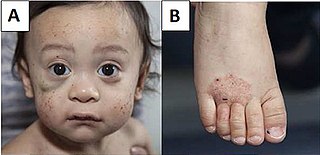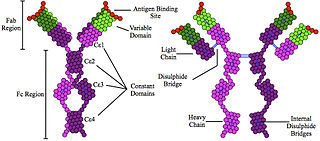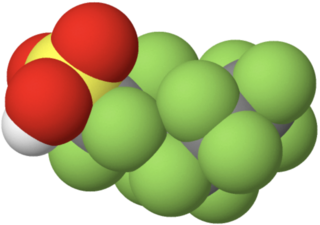
Latex allergy is a medical term encompassing a range of allergic reactions to the proteins present in natural rubber latex. It generally develops after repeated exposure to products containing natural rubber latex. When latex-containing medical devices or supplies come in contact with mucous membranes, the membranes may absorb latex proteins. In some susceptible people, the immune system produces antibodies that react immunologically with these antigenic proteins. Many items contain or are made from natural rubber, including shoe soles, pen grips, hot water bottles, elastic bands, rubber gloves, condoms, baby-bottle nipples, and balloons; consequently, there are many possible routes of exposure that may trigger a reaction. People with latex allergies may also have or develop allergic reactions to some fruits, such as bananas.

Hypereosinophilic syndrome is a disease characterized by a persistently elevated eosinophil count in the blood for at least six months without any recognizable cause, with involvement of either the heart, nervous system, or bone marrow.
The National Institute of Allergy and Infectious Diseases is one of the 27 institutes and centers that make up the National Institutes of Health (NIH), an agency of the United States Department of Health and Human Services (HHS). NIAID's mission is to conduct basic and applied research to better understand, treat, and prevent infectious, immunologic, and allergic diseases.

Wiskott–Aldrich syndrome (WAS) is a rare X-linked recessive disease characterized by eczema, thrombocytopenia, immune deficiency, and bloody diarrhea. It is also sometimes called the eczema-thrombocytopenia-immunodeficiency syndrome in keeping with Aldrich's original description in 1954. The WAS-related disorders of X-linked thrombocytopenia (XLT) and X-linked congenital neutropenia (XLN) may present with similar but less severe symptoms and are caused by mutations of the same gene.

Cold urticaria is a disorder in which large red welts called hives (urticaria) form on the skin after exposure to a cold stimulus. The hives are usually itchy and often the hands, feet and other parts of the body will become itchy and swollen as well. Hives vary in size from about 7 mm in diameter to as big as about 27 mm or larger.
Food intolerance is a detrimental reaction, often delayed, to a food, beverage, food additive, or compound found in foods that produces symptoms in one or more body organs and systems, but generally refers to reactions other than food allergy. Food hypersensitivity is used to refer broadly to both food intolerances and food allergies.

Nasal congestion is the partial or complete blockage of nasal passages, leading to impaired nasal breathing, usually due to membranes lining the nose becoming swollen from inflammation of blood vessels.
Oral allergy syndrome (OAS) or pollen-food allergy syndrome (PFAS) is a type of allergy classified by a cluster of allergic reactions in the mouth and throat in response to eating certain fruits, nuts, and vegetables. It typically develops in adults with hay fever. It is not usually serious.

Hyperimmunoglobulinemia E syndrome (HIES), of which the autosomal dominant form is called Job's syndrome or Buckley syndrome, is a heterogeneous group of immune disorders. Job's is also very rare at about 300 cases currently in the literature.
An immune disorder is a dysfunction of the immune system. These disorders can be characterized in several different ways:
Per- and polyfluoroalkyl substances are a group of synthetic organofluorine chemical compounds that have multiple fluorine atoms attached to an alkyl chain; there are 7 million such chemicals according to PubChem. PFAS came into use after the invention of Teflon in 1938 to make fluoropolymer coatings and products that resist heat, oil, stains, grease, and water. They are now used in products including waterproof fabric such as Nylon, yoga pants, carpets, shampoo, feminine hygiene products, mobile phone screens, wall paint, furniture, adhesives, food packaging, heat-resistant non-stick cooking surfaces such as Teflon, firefighting foam, and the insulation of electrical wire. PFAS are also used by the cosmetic industry in most cosmetics and personal care products, including lipstick, eye liner, mascara, foundation, concealer, lip balm, blush, and nail polish.

PF-03654746 is a potent and selective histamine H3 receptor antagonist developed by Pfizer and currently undergoing clinical trials for the treatment of ADHD, Tourette syndrome as well as potential anti-allergy applications.

The Philadelphia Female Anti-Slavery Society (PFASS) was founded in December 1833, a few days after the first meeting of the American Anti-Slavery Society, and dissolved in March 1870 following the ratification of the 14th and 15th Amendments to the U.S. Constitution. It was founded by eighteen women, including Lucretia Mott, Mary Ann M'Clintock, Margaretta Forten, her mother Charlotte, and Forten's sisters Sarah and Harriet.
Alpha-gal syndrome (AGS), also known as alpha-gal allergy or mammalian meat allergy (MMA), is a type of acquired allergy characterized by a delayed onset of symptoms after ingesting mammalian meat. The condition results from past exposure to certain tick bites and was first reported in 2002. Symptoms of the allergy vary greatly between individuals and include rash, hives, nausea or vomiting, difficulty breathing, drop in blood pressure, dizziness or faintness, diarrhea, severe stomach pain, and possible anaphylaxis.
Meat allergy can refer to:
Mast cell activation syndrome (MCAS) is a term referring to one of two types of mast cell activation disorder (MCAD); the other type is idiopathic MCAD. MCAS is an immunological condition in which mast cells, a type of white blood cell, inappropriately and excessively release chemical mediators, such as histamine, resulting in a range of chronic symptoms, sometimes including anaphylaxis or near-anaphylaxis attacks. Primary symptoms include cardiovascular, dermatological, gastrointestinal, neurological, and respiratory problems.
GenX is a Chemours trademark name for a synthetic, short-chain organofluorine chemical compound, the ammonium salt of hexafluoropropylene oxide dimer acid (HFPO-DA). It can also be used more informally to refer to the group of related fluorochemicals that are used to produce GenX. DuPont began the commercial development of GenX in 2009 as a replacement for perfluorooctanoic acid, in response to legal action due to the health effects and ecotoxicity of PFOA.

Perfluorosulfonic acids (PFSAs) are chemical compounds of the formula CnF(2n+1)SO3H and thus belong to the family of perfluorinated and polyfluorinated alkyl compounds (PFASs). The simplest example of a perfluorosulfonic acid is the trifluoromethanesulfonic acid. Perfluorosulfonic acids with six or more perfluorinated carbon atoms, i.e. from perfluorohexanesulfonic acid onwards, are referred to as long-chain.

Perfluorohexanesulfonic acid (PFHxS) is a synthetic chemical compound. It is one of many compounds collectively known as per- and polyfluoroalkyl substances (PFASs). It is an anionic fluorosurfactant and a persistent organic pollutant with bioaccumulative properties. Although the use of products containing PFHxS and other PFASs have been banned or are being phased out in many jurisdictions, it remains ubiquitous in many environments and within the general population, and is one of the most commonly detected PFASs.
Remediation of per- and polyfluoroalkyl substances refers to the destruction or removal of per- and polyfluoroalkyl substances (PFASs) from the environment. PFASs are a group of synthetic organofluorine compounds, used in diverse products such as non-stick cookware and firefighting foams, that have attracted great concern as persistent organic pollutants. Because they are pervasive and have adverse effects, much interest has focused on their removal.









